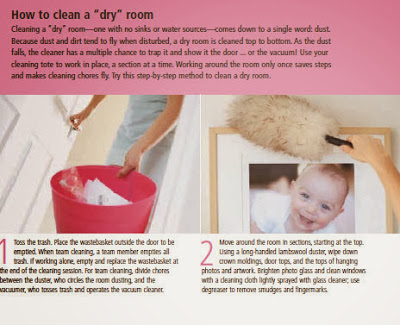Cut costs in the broom closet: cleaning tools
Supermarket sponge-mops and “as seen on TV” cleaning marvels may seem like bargains, but buying a succession of cheap tools and single-use gimcracks can be costly—and it won’t get the house clean. Fill your broom closet with a set of durable, versatile cleaning tools, such as these tried-and-true workhorses of the cleaning world.
Floor cleaners:
Mops Whether used for wet or dry cleaning, mops are the foot soldiers in the battle for clean floors. Every organized home needs at least two: a wet mop, to pick up wet spills and wash hard-surface floors; and a dry mop, to collect dry dust, dirt, and pet hair.
When choosing a mop for wet cleaning, bear in mind its purpose—not only should it dissolve dirt, but it must also lift it from the floor and remove it. For this reason, avoid string mops. They are heavy to lift, awkward to use, and nearly impossible to rinse clean.
Instead, look for large-headed wet mops with a swivel base and removable terry covers. These innovative tools do dual duty; a dry cover makes quick work of spilled liquids, while a cover wrung out in cleaning solution dissolves and lifts dirt easily. As the cover becomes soiled, simply replace it with a freshly wrung one.
To finish, a dry cover polishes away the last of the water—and since the terry covers can be machine-washed and dried, then reused, you’ll avoid the expense and environmental problems of disposable mop liners.
Sponge mops, too, offer efficient cleaning for spills and floors. Larger cleaning heads make the job fly faster. Because these mops get a workout, make sure hinge mechanisms are made of metal; plastic won’t stand up to the job.
Dry mops are available in many forms. Small disposable mops have the advantage of sliding easily into tight corners and are a favorite with young helpers, but they can be flimsy —and replacement pads are expensive.
Reusable microfiber mops offer a less costly alternative. Some microfiber mops use hook-and-loop tape to attach washable dry-mop pads to the mop face. Others replace disposable pads with reusable microfiber sheets. Use them on dry soil and to sweep up crumbs in the kitchen.
When buying a dry mop, examine the handle and hinge assembly. Mopping stresses these areas, so look for metal connectors and swivels.
Brooms These come in three basic types: push, synthetic, and corn. Push brooms are made from synthetic bristles arrayed in a wide flat base. They’re used to sweep large areas like the center of indoor rooms, garages, and patios. Rougher bristles allow the push broom to tackle irregular surfaces.
Choose a push broom with tacked-in bristles, avoiding brooms that are merely glued together. Look for a metal coupling between the handle and the head; the stresses of sweeping will wear out plastic fittings quickly.
Angled synthetic brooms are lightweight and work well to clean near baseboards, behind furniture, and in corners.
Use them indoors, as their lighter weight makes them impractical for heavier outdoor jobs. Store synthetic brooms head-up to avoid bending the bristles.
Corn brooms are made from natural bristles, and they’re the all-purpose solution for sweeping chores. Pair them with a dustpan for quick kitchen clean-ups; the rough bristles do a superior job on flooring material with a coarse or pitted surface that holds dirt, such as brick or concrete.
When buying a corn broom, look for a smooth, strong handle, and multiple rows of stitching to hold the bristles in place. Store the corn broom head-up to prevent the bristles from bending. As the broom ages, trim the bristles an inch or so to restore it to youthful vigor.


Enregistrer un commentaire